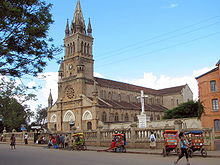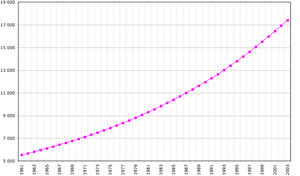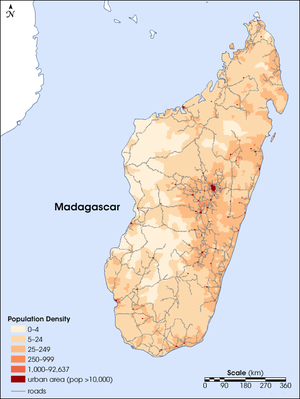- Demographics of Madagascar
-
This article is about the demographic features of the population of Madagascar, including population density, ethnicity, education level, health of the populace, economic status, religious affiliations and other aspects of the population.
Madagascar's population is predominantly of mixed Austronesian and East African origin.
Contents
Ethnicity
Recent research suggests that the island was uninhabited until Austronesian seafarers arrived around the first century A.D., probably by way of southern India and East Africa. Other historians believe that the Malays crossed the Indian Ocean and only reached the African mainland after having established durable communities on Madagascar. Subsequent migrations from both the Malay Archipelago and Africa further consolidated this original mixture, and 18 separate tribal groups emerged. Austronesian features are most predominant in the central highlands people, the Merina (3 million) and the Betsileo (2 million); the remaining 16 tribal groupings are coastal peoples (côtiers) who are predominantly of East African origin, with various Malay, Arab, European and Indian admixtures. The largest coastal groups are the Betsimisaraka (1.5 million) and the Tsimihety and Sakalava (700,000 each). Malagasy society has long been polarized between the politically and economically advantaged highlanders of the central plateaux and the côtiers along the coast. For example in the 1970s there was widespread opposition among côtiers against the policy of Malgachisation which intended to phase out the use of the French language in public life in favour of a more prominent position for the Malagasy language, whose orthography is based on the Merina dialect. Identity politics were also at the core of the brief civil unrest during 2002.
The Malagasy language is of Malayo-Polynesian origin and is spoken throughout the island. French also is spoken among the educated population of this former French colony, primarily as a prestigious second language.
Indians in Madagascar descend mostly from traders who arrived in the newly-independent nation looking for better opportunities. The majority of them came from the west coast of India known as Karana (Muslim) and Banian (Hindu). The majority speak Hindi or Gujarati, and though some other Indian dialects also exist. Nowadays[update] the younger generations speak at least three languages, including French, Gujarati and Malagasy. A large number of the Indians in Madagascar have a high level of education, particularly the younger generation.[citation needed]
A sizeable number of Europeans also reside in Madagascar, mostly of French descent.
Religion
Most people practice traditional religions, which tend to emphasize links between the living and the dead. They believe that the dead join their ancestors in the ranks of divinity and that ancestors are intensely concerned with the fate of their living descendants. This spiritual communion is celebrated by the Merina and Betsileo reburial practice of famadihana, or "turning over the dead." In this ritual, relatives' remains are removed from the family tomb, rewrapped in new silk shrouds, and returned to the tomb following festive ceremonies in their honor. In the festivities, they eat, drink, and literally dance with the dead. After one or two days of celebrating, they shower the body with gifts and re-bury it.
About 45% of the Malagasy are Christian, divided almost evenly between Roman Catholic and Protestant, but there are also Orthodox Christians. Many incorporate the cult of the dead with their other religious beliefs and bless their dead at church before proceeding with the traditional burial rites. They also may invite a pastor to attend a famadihana. A historical rivalry exists between the predominantly Catholic masses, considered to be underprivileged, and the predominantly Protestant Merina aristocrats, who tend to prevail in the civil service, business, and professions.
Islam has been well-established in what is now known as Madagascar for centuries and today Muslims represent 10 to 15 percent of the population.[1]
A new policy of decentralizing resources and authority is intended to enhance the development potential of all Madagascar's provinces. Provincial Council members were elected by popular vote in December 2000. In March 2001, the new Provincial Council members joined mayors and communal council members in each province in electing Senators to represent them in the national parliament. Governors were elected by Electoral College in June 2001. Transfer of Duties and Establishments of budgets are now in progress.
See also: Christianity in Madagascar, Islam in Madagascar, Hinduism in Madagascar, and Bahá'í Faith in Madagascar.
CIA World Factbook demographic statistics
The following demographic statistics are from the CIA World Factbook, unless otherwise indicated.[2]
Population:
18,652,000 (July 2006 est.)
Age structure:
0-14 years: 45% (male 3,504,562; female 3,481,056)
15-64 years: 52% (male 3,964,564; female 4,052,056)
65 years and over: 3% (male 237,691; female 266,543) (2006 est.)Population growth rate: 2.69% (2006 est.)
Birth rate: 37.82 births/1,000 population (2006 est.)
Death rate: 9.79 deaths/1,000 population (2006 est.)
Net migration rate: 0 migrant(s)/1,000 population (2006 est.)
Sex ratio:
at birth: 1.03 male(s)/female
under 15 years: 1.01 male(s)/female
15-64 years: 0.98 male(s)/female
65 years and over: 0.89 male(s)/female
total population: 0.99 male(s)/female (2000 est.)Infant mortality rate: 65.59 deaths/1,000 live births (2006 est.)
Life expectancy at birth:
total population: 59.45 years
male: 57.72 years
female: 61.33 years (2006 est.)Total fertility rate: 5.02 children born/woman (2011 est.)
Nationality:
noun: Malagasy (singular and plural)
adjective: MalagasyEthnic groups: Malayo-Indonesian (Merina and related Betsileo), Côtiers (mixed African, Malayo-Indonesian, and Arab ancestry - Betsimisaraka, Tsimihety, Antaisaka, Sakalava), French, Desi, Creole, Comorian, Chinese
Religions: indigenous beliefs 52%, Christian 41%, Muslim 7%
Languages: Malagasy (official, and national language), French (official), English (official) [3]
Literacy:
definition: age 15 and over can read and write
total population: 80%
male: 88%
female: 73% (1990 est.)Notes
- ^ Madagascar
- ^ The World Factbook - Madagascar
- ^ Madagascar adopts English as official language, ClickAfrique.com, 10 April 2007.
References
- Matthew E. Hules, et al. (2005). The Dual Origin of the Malagasy in Island Southeast Asia and East Africa: Evidence from Maternal and Paternal Lineages. American Journal of Human Genetics, 76:894-901, 2005.
Demographics of Africa Sovereign
states- Algeria
- Angola
- Benin
- Botswana
- Burkina Faso
- Burundi
- Cameroon
- Cape Verde
- Central African Republic
- Chad
- Comoros
- Democratic Republic of the Congo
- Republic of the Congo
- Côte d'Ivoire (Ivory Coast)
- Djibouti
- Egypt
- Equatorial Guinea
- Eritrea
- Ethiopia
- Gabon
- The Gambia
- Ghana
- Guinea
- Guinea-Bissau
- Kenya
- Lesotho
- Liberia
- Libya
- Madagascar
- Malawi
- Mali
- Mauritania
- Mauritius
- Morocco
- Mozambique
- Namibia
- Niger
- Nigeria
- Rwanda
- São Tomé and Príncipe
- Senegal
- Seychelles
- Sierra Leone
- Somalia
- South Africa
- South Sudan
- Sudan
- Swaziland
- Tanzania
- Togo
- Tunisia
- Uganda
- Zambia
- Zimbabwe
States with limited
recognition- Sahrawi Arab Democratic Republic
- Somaliland
Dependencies and
other territories- Canary Islands / Ceuta / Melilla / Plazas de soberanía (Spain)
- Madeira (Portugal)
- Mayotte / Réunion (France)
- Saint Helena / Ascension Island / Tristan da Cunha (United Kingdom)
- Western Sahara
Categories:- Malagasy society
- Demographics by country
Wikimedia Foundation. 2010.



